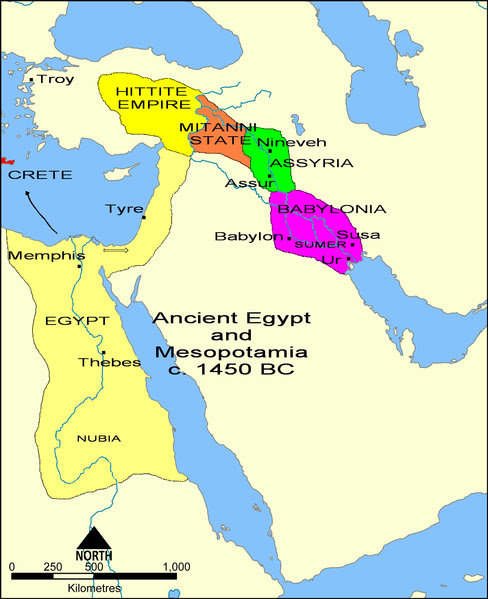Once friendly relations were firmly established with Thutmose III's powerful Egypt, Assyria turned southward to Babylonia. Other than the Mitanni, who once rattled their borders with oppressive raids prior to Egypt's intervention, Babylonia, as ruled by the Kassites, was the nearest neighboring civilization. Following Egypt's grand conquest of the Near East's coast and strategic areas within the Mesopotamia, now was the perfect opportunity for the Assyrian king, Puzur-Ashur IV (1486-1460 B.C.), to address the Babylonian Question.
Would it be peace or war?
The Egyptians had seen fit to allow resident countries to preside over agreed upon boundaries as long as they continued to pay tribute (taxes) in the form of goods and precious rocks and metals used for what passed as currency at that time. How these different peoples interacted with one another was an entirely separate matter.
Not much is known of Puzur-Ashur's reign of Assyria, other than a few short pieces of note:
- He restored the temple of Ishtar, which one might surmise was thoroughly desecrated at the hands and ill-treatment by their immediate neighbors, the Mitanni, though this is unconfirmed. At present, historians have it on record that the temple did fall into a state of decay and he'd restored it back to its once pristine condition, no less fit for Assyria's chief place of reverence.
- While no major battles or wars are accounted for during his lifetime, the Assyrian king did commit strenuous efforts and time dedicated to the building of a new defensive structure, a protective wall for Ashur, their capital city, that would shield the newer southern districts that their growing population had rapidly expanded into, a much needed response to any outside danger.
- But perhaps his grandest recorded accomplishment was the negotiations with the Kassite ruler of Babylon, Burna-Buriash I (1461-1436), where the two met and agreed upon establishing the precise borders between their respective kingdoms. Assyria already carried the experience in such negotiations with the Egyptian empire, that in this case, found themselves as leading the way as opposed to following, and as it was between Thutmose III and Puzur-Ashur IV, it was with Puzar-Ashur IV and Burna-Buriash I.
For the many years that followed, there was a prolonged period of peacetime amongst kingdoms and empires. At one point Burna-Buriash I's successor, Kurigalzu II (1435-1411), was invited by the Canaanites to wage war against Egypt, with a promise of a piece of the Semitic lands that they were so desperately yearning to liberate. To this, Kurigalzu declined, and each of his successors were continually solicited to turn against the great empire of the Near East. Just as their forbearer once demonstrated, each Babylonian ruler also declined, referring to the Egyptian pharaoh as "my brother."
The Egyptians had established dominance for this century (15th century B.C.) by making friends where enemies might once had surfaced. However, as history will often remind, nothing lasts forever, especially in the case of the status quo.




No comments:
Post a Comment